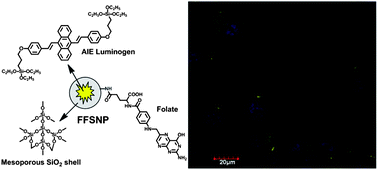Folic acid-functionalized mesoporous silica nanospheres hybridized with AIE luminogens for targeted cancer cell imaging†
Abstract
Fluorescent nanoparticles (FNPs) have been found to be useful as visualization tools for biological sensing, probing, imaging, and monitoring. Applied to targeted cancer cell imaging, FNPs are highly desirable for early stage cancer diagnosis and treatment. However, the light emission from most of the FNPs reported is severely limited because of the aggregation-caused quenching (ACQ) effect. Herein, we present highly emissive inorganic–organic nanoparticles with core–shell structures for targeted cancer cell imaging. Coated with a folate-functionalized silica shell, 9,10-distyrylanthracene (DSA) fluorogens with aggregation-induced emission (AIE) properties served as the fluorescent core, affording folate-functionalized fluorescent silica nanoparticles (FFSNPs) with a high fluorescence quantum yield (up to 20%). The FFSNPs are of small size (diameter ∼60 nm), monodispersed, stable in aqueous suspension, and pose little toxicity to living cells and thus can be utilized for targeted HeLa cell imaging. In addition, the FFSNPs are mesoporous and therefore can potentially be used as vehicles for controlled, externally activated release of anticancer drugs.


 Please wait while we load your content...
Please wait while we load your content...